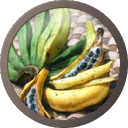Whole genome sequencing of a banana wild relative Musa itinerans provides insights into lineage-specific diversification of the Musa genus.
Summary
| Abstract | Crop wild relatives are valuable resources for future genetic improvement. Here, we report the de novo genome assembly of Musa itinerans, a disease-resistant wild banana relative in subtropical China. The assembled genome size was 462.1 Mb, covering 75.2% of the genome (615.2Mb) and containing 32, 456 predicted protein-coding genes. Since the approximate divergence around 5.8 million years ago, the genomes of Musa itinerans and Musa acuminata have shown conserved collinearity. Gene family expansions and contractions enrichment analysis revealed that some pathways were associated with phenotypic or physiological innovations. These include a transition from wood to herbaceous in the ancestral Musaceae, intensification of cold and drought tolerances, and reduced diseases resistance genes for subtropical marginally distributed Musa species. Prevalent purifying selection and transposed duplications were found to facilitate the diversification of NBS-encoding gene families for two Musa species. The population genome history analysis of M. itinerans revealed that the fluctuated population sizes were caused by the Pleistocene climate oscillations, and that the formation of Qiongzhou Strait might facilitate the population downsizing on the isolated Hainan Island about 10.3 Kya. The qualified assembly of the M. itinerans genome provides deep insights into the lineage-specific diversification and also valuable resources for future banana breeding. | ||
|---|---|---|---|
| Publication Date | 17 August 2016 | ||
| DOI | 10.1038/srep31586 | ||
| Cross Reference |
| ||
| Citation | Wu W, Yang YL, He WM, Rouard M, Li WM, Xu M, Roux N, Ge XJ. Whole genome sequencing of a banana wild relative Musa itinerans provides insights into lineage-specific diversification of the Musa genus.. Scientific reports. 2016 08 17; 6:31586. |





